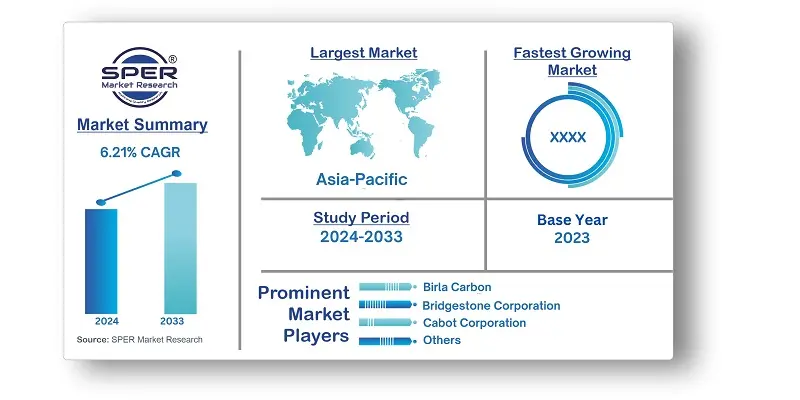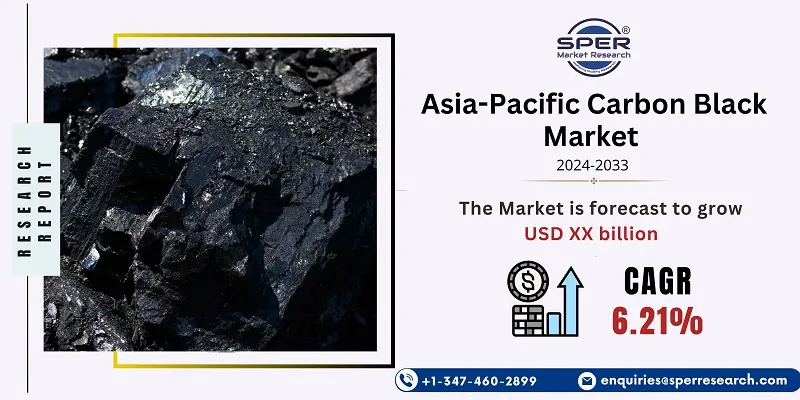
Asia Pacific Carbon Black Market Growth, Size, Trends, Demand, Share, Revenue and Future Outlook
Asia-Pacific Carbon Black Market Size- By Type, By Grade, By Application- Regional Outlook, Competitive Strategies and Segment Forecast to 2033
| Published: Jun-2024 | Report ID: CHEM2463 | Pages: 1 - 151 | Formats*: |
| Category : Chemical & Materials | |||
- APRIL 2023: In order to begin producing carbon black for sale, Phillips Carbon Black, a division of the RP-Sanjiv Goenka Group, constructed a new production plant in Tamil Nadu, India, in April 2023. By 2023, it is anticipated that the firm will be producing 147 kilotons per year.
- September 2022: With an investment of INR 550 Crore, Epsilon Carbon intended to double the capacity of carbon black production in Vijayanagar, Karnataka, India. The business expanded from 115 to 215 kilotons of production capacity, and it now distributes carbon black to numerous businesses in the tire and non-tire industries.


| Report Metric | Details |
| Market size available for years | 2020-2033 |
| Base year considered | 2023 |
| Forecast period | 2024-2033 |
| Segments covered | By Type, By Grade, By Application |
| Regions covered | China, India, Japan, Australia, South Korea, Rest of Asia- Pacific |
| Companies Covered | Birla Carbon, Bridgestone Corporation, Cabot Corporation, Cancarb Limited, Continental Carbon Company, Epsilon Carbon Private Limited, Himadri Speciality Chemical Ltd., Imerys, Longxing Chemical Stock Co. Ltd. |
- Automobile Industry
- Rubber Industry
- Plastic Industry
- Construction Industry
- Ink and Coating Industry
- Electronics Industry
- Chemical Industry
- Packaging Industry
- Textile Industry
- Energy Sector
| By Type: |
|
| By Grade: |
|
| By Application: |
|
- Asia-Pacific Carbon Black Market Size (FY’2024-FY’2033)
- Overview of Asia-Pacific Carbon Black Market
- Segmentation of Asia-Pacific Carbon Black Market By Type (Acetylene Black, Channel Black, Furnace Black, Thermal Black, Others)
- Segmentation of Asia-Pacific Carbon Black Market By Grade(Acetylene Black, Channel Black, Furnace Black, Thermal Black, Others)
- Segmentation of Asia-Pacific Carbon Black Market By Application(Tire, Non-Tire Rubber, Plastics, Inks and Coatings Others)
- Statistical Snap of Asia-Pacific Carbon Black Market
- Expansion Analysis of Asia-Pacific Carbon Black Market
- Problems and Obstacles in Asia-Pacific Carbon Black Market
- Competitive Landscape in the Asia-Pacific Carbon Black Market
- Impact of COVID-19 and Demonetization on Asia-Pacific Carbon Black Market
- Details on Current Investment in Asia-Pacific Carbon Black Market
- Competitive Analysis of Asia-Pacific Carbon Black Market
- Prominent Players in the Asia-Pacific Carbon Black Market
- SWOT Analysis of Asia-Pacific Carbon Black Market
- Asia-Pacific Carbon Black Market Future Outlook and Projections (FY’2024-FY’2033)
- Recommendations from Analyst
1.1. Scope of the report1.2. Market segment analysis
2.1. Research data source2.1.1. Secondary Data2.1.2. Primary Data2.1.3. SPER’s internal database2.1.4. Premium insight from KOL’s2.2. Market size estimation2.2.1. Top-down and Bottom-up approach2.3. Data triangulation
4.1. Driver, Restraint, Opportunity and Challenges analysis4.1.1. Drivers4.1.2. Restraints4.1.3. Opportunities4.1.4. Challenges4.2. COVID-19 Impacts of the Asia-Pacific Carbon Black Market
5.1. SWOT Analysis5.1.1. Strengths5.1.2. Weaknesses5.1.3. Opportunities5.1.4. Threats5.2. PESTEL Analysis5.2.1. Political Landscape5.2.2. Economic Landscape5.2.3. Social Landscape5.2.4. Technological Landscape5.2.5. Environmental Landscape5.2.6. Legal Landscape5.3. PORTER’s Five Forces5.3.1. Bargaining power of suppliers5.3.2. Bargaining power of buyers5.3.3. Threat of Substitute5.3.4. Threat of new entrant5.3.5. Competitive rivalry5.4. Heat Map Analysis
6.1. Asia-Pacific Carbon Black Market Manufacturing Base Distribution, Sales Area, Product Type6.2. Mergers & Acquisitions, Partnerships, Product Launch, and Collaboration in Asia-Pacific Carbon Black Market
7.1. Asia-Pacific Carbon Black Market Size, Share and Forecast, By Type, 2020-20267.2. Asia-Pacific Carbon Black Market Size, Share and Forecast, By Type, 2027-20337.3. Acetylene Black7.4. Channel Black7.5. Furnace Black7.6. Thermal Black7.7. Others
8.1. Asia-Pacific Carbon Black Market Size, Share and Forecast, By Grade, 2020-20268.2. Asia-Pacific Carbon Black Market Size, Share and Forecast, By Grade, 2027-20338.3. Standard Grade8.4. Speciality Grade
9.1. Asia-Pacific Carbon Black Market Size, Share and Forecast, By Application, 2020-20269.2. Asia-Pacific Carbon Black Market Size, Share and Forecast, By Application, 2027-20339.3. Tire9.4. Non-Tire Rubber9.5. Plastics9.6. Inks & Coatings9.7. Others
10.1. Asia-Pacific Carbon Black Market Size and Market Share
11.1. Asia-Pacific Carbon Black Market Size and Market Share By Region (2020-2026)11.2. Asia-Pacific Carbon Black Market Size and Market Share By Region (2027-2033)11.3. Japan11.4. China11.5. India11.6. Australia11.7. South Korea11.8. Rest of Asia Pacific
12.1. Birla Carbon12.1.1. Company details12.1.2. Financial outlook12.1.3. Product summary12.1.4. Recent developments12.2. Bridgestone Corporation12.2.1. Company details12.2.2. Financial outlook12.2.3. Product summary12.2.4. Recent developments12.3. Cabot Corporation12.3.1. Company details12.3.2. Financial outlook12.3.3. Product summary12.3.4. Recent developments12.4. Cancarb Limited12.4.1. Company details12.4.2. Financial outlook12.4.3. Product summary12.4.4. Recent developments12.5. Continental Carbon Company12.5.1. Company details12.5.2. Financial outlook12.5.3. Product summary12.5.4. Recent developments12.6. Epsilon Carbon Private Limited12.6.1. Company details12.6.2. Financial outlook12.6.3. Product summary12.6.4. Recent developments12.7. Himadri Speciality Chemical Ltd.12.7.1. Company details12.7.2. Financial outlook12.7.3. Product summary12.7.4. Recent developments12.8. Imerys12.8.1. Company details12.8.2. Financial outlook12.8.3. Product summary12.8.4. Recent developments12.9. Longxing Chemical Stock Co. Ltd.12.9.1. Company details12.9.2. Financial outlook12.9.3. Product summary12.9.4. Recent developments12.10. Others
SPER Market Research’s methodology uses great emphasis on primary research to ensure that the market intelligence insights are up to date, reliable and accurate. Primary interviews are done with players involved in each phase of a supply chain to analyze the market forecasting. The secondary research method is used to help you fully understand how the future markets and the spending patterns look likes.
The report is based on in-depth qualitative and quantitative analysis of the Product Market. The quantitative analysis involves the application of various projection and sampling techniques. The qualitative analysis involves primary interviews, surveys, and vendor briefings. The data gathered as a result of these processes are validated through experts opinion. Our research methodology entails an ideal mixture of primary and secondary initiatives.



Frequently Asked Questions About This Report
PLACE AN ORDER
Year End Discount
Sample Report
Pre-Purchase Inquiry
NEED CUSTOMIZATION?
Request CustomizationCALL OR EMAIL US
100% Secure Payment






Related Reports
Our Global Clients
Our data-driven insights have influenced the strategy of 200+ reputed companies across the globe.




















